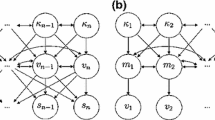Abstract
Bayesian updating methods provide an alternate philosophy to the characterization of the input variables of a stochastic mathematical model. Here, a priori values of statistical parameters are assumed on subjective grounds or by analysis of a data base from a geologically similar area. As measurements become available during site investigations, updated estimates of parameters characterizing spatial variability are generated. However, in solving the traditional updating equations, an updated covariance matrix may be generated that is not positive-definite, particularly when observed data errors are small. In addition, measurements may indicate that initial estimates of the statistical parameters are poor. The traditional procedure does not have a facility to revise the parameter estimates before the update is carried out. alternatively, Bayesian updating can be viewed as a linear inverse problem that minimizes a weighted combination of solution simplicity and data misfit. Depending on the weight given to the a priori information, a different solution is generated. A Bayesian updating procedure for log-conductivity interpolation that uses a singular value decomposition (SVD) is presented. An efficient and stable algorithm is outlined that computes the updated log-conductivity field and the a posteriori covariance of the estimated values (estimation errors). In addition, an information density matrix is constructed that indicates how well predicted data match observations. Analysis of this matrix indicates the relative importance of the observed data. The SVD updating procedure is used to interpolate the log-conductivity fields of a series of hypothetical aquifers to demonstrate pitfalls and possibilities of the method.
Similar content being viewed by others
References
Backus, G. E., 1988, Bayesian Inference in Geomagnetism: Geophys. J., v. 92, p. 125–142.
Bryson, A. E.; and Ho, Y., 1975, Applied Optimal Control: Hemisphere, p. 377–382.
Forsythe, G.E.; Malcolm, M. A.; and Moler, C. B., 1977, Computer Methods For Mathematical Computations: Prentice-Hall, Englewood Cliffs, New Jersey, 259 p.
Franklin, J., 1970, Well-Posed Stochastic Extensions of Ill-Posed Linear Problems: J. Math. Anal. Appl., v. 31, p. 682–716.
Golub, G. H.; and Van Loan, C. F., 1983, Matrix Computations: Johns Hopkins University Press, Baltimore, 476 p.
Hachich, W.; and Vanmarcke, E H., 1983, Probabilistic Updating of Pore Pressure Fields: J. Geotech. Eng. Div. Am. Soc. Civ. Eng., v. 109, p. 373–385.
Hoeksema, R. J.; and Kitanidis, P. K., 1985a, Analysis of the Spatial Structure of Properties of Selected Aquifers: Water Resour. Res., v. 21, p. 563–572.
Hoeksema, R. J.; and Kitanidis, P. K., 1985b, Comparison of Gaussian Conditional Mean and Kriging Estimation in the Geostatistical Solution to the Inverse Problem: Water Resour. Res., v. 21, p. 825–836.
Jackson, D. D., 1972, Interpretation of Inaccurate, Insufficient, and Inconsistent Data: Geophys. J. R. Astron. Soc., v. 28, p. 97–109.
Jackson, D. D., 1979, The Use of a priori Data to Resolve Non-Uniqueness in Linear Inversion: Geophys. J. R. Astron. Soc., v. 57, p. 137–157.
Journel, A. G.; and Huijbregts, C. J., 1978, Mining Geostatitics: Academic Press, New York, 600 p.
Kitanidis, P. K., 1986, Parameter Uncertainty in Estimation of Spatial Functions: Bayesian Analysis: Water Resour. Res., v. 22, p. 499–507.
Lawson, C. L.; and Hanson, R. J., 1974, Solving Least Squares Problems: Prentice-Hall, Englewood Cliffs, New Jersey, 340 p.
Massmann, J.; and Freeze, R. A., 1987, Groundwater Contamination from Waste Management Sites: the Interaction Between Risk-Based Engineering Design and Regulatory Policy. 1. Methodology: Water Resour. Res., v. 23, p. 351–367.
Massmann, J.; and Freeze, R. A., 1988, Erratum and Addendum: Groundwater Contamination from Waste Management Sites: the Interaction Between Risk-Based Engineering Design and Regulatory Policy. 1. Methodology: Water Resour. Res. (in press).
Maybeck, P. S., 1979, Stochastic Models: Estimation and Control, v. 1: Academic Press, New York, p. 115–407.
Menke, W., 1984, Geophysical Data Analysis: Discrete Inverse Theory: Academic Press, New York, 260 p.
Neuman, S. P.; and Yakowitz, S., 1979, A Statistical Approach to the Inverse Problem in Aquifer Hydrology: Theory: Water Resour. Res., v. 15, p. 845–860.
Oldenburg, D. W., 1984, An Introduction to Linear Inverse Theory: IEEE Trans. Geosi. Remote Sens., v. GE-22, p. 665–674.
Parker, R. L., 1977, Understanding Inverse Theory: Annu. Rev. Earth Planet, Sci., v. 5, p. 35–64.
Parker, R. L.; and NcNutt, M. K., 1980, Statistics for the One-Norm Misfit Measure: J. Geophys. Res., B, v. 85, p. 4429–4430.
Tarantola, A., 1987, Inverse Problem Theory: Elsevier, Amsterdam, 613 p.
Wiggins, R. A., 1972, The General Linear Inverse Problem: Implication of Surface Wave and Free Oscillation for Earth Structure: Rev. Geophys., v. 10, p. 251–285.
Woodbury, A. D., 1987, Inverse Theory and Model Identifiability: an Overview, p. in R. N. Yong (ed.), Proceedings CSCE Centennial Conference, Montreal, Canada, May, p. 119–144.
Woodbury, A. D.; Smith, L.; and Dunbar, W. S., 1987, Simultaneous Inversion of Hyrdogeologic and Thermal Data. 1. Theory and Application Using Hydraulic Head Data: Water Resour. Res., v. 23, p. 1586–1606.
Author information
Authors and Affiliations
Rights and permissions
About this article
Cite this article
Woodbury, A.D. Bayesian updating revisited. Math Geol 21, 285–308 (1989). https://doi.org/10.1007/BF00893691
Received:
Accepted:
Issue Date:
DOI: https://doi.org/10.1007/BF00893691




